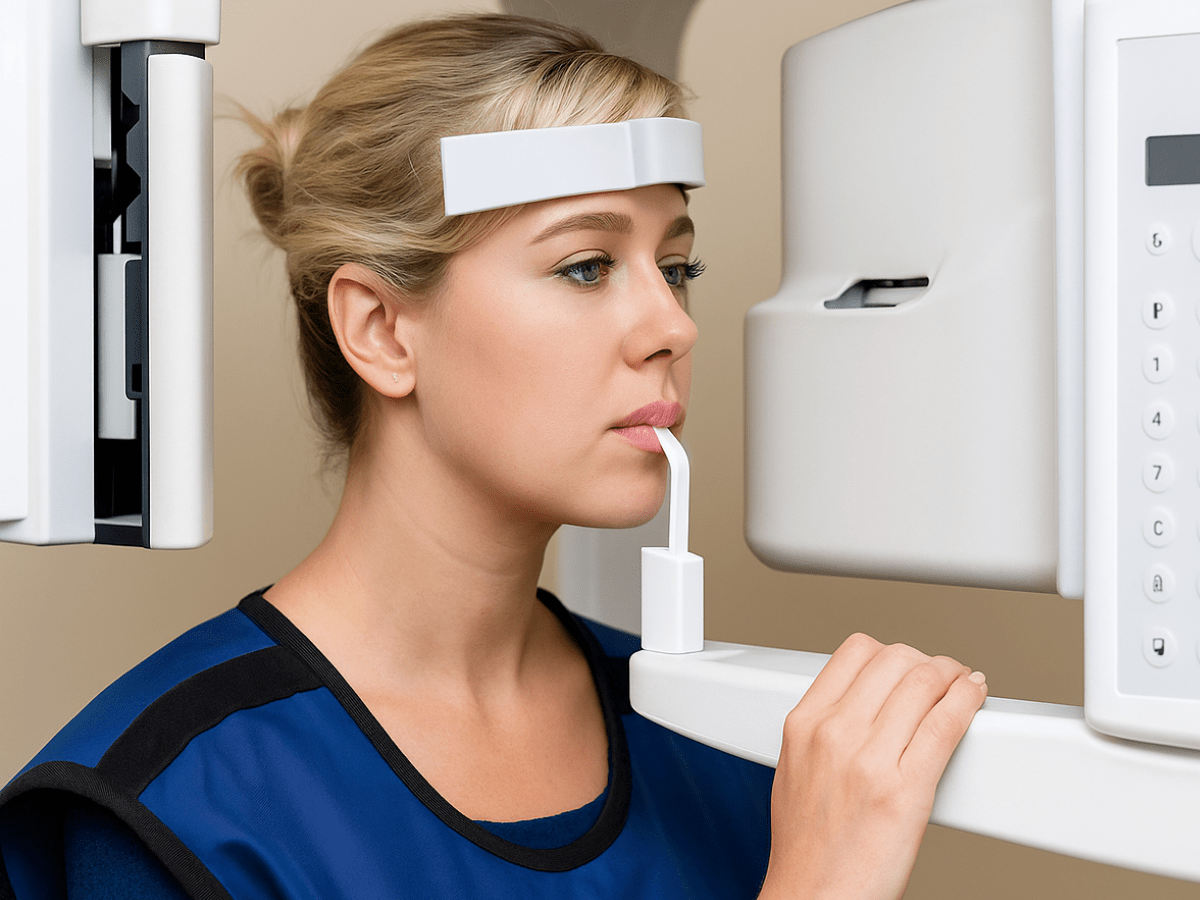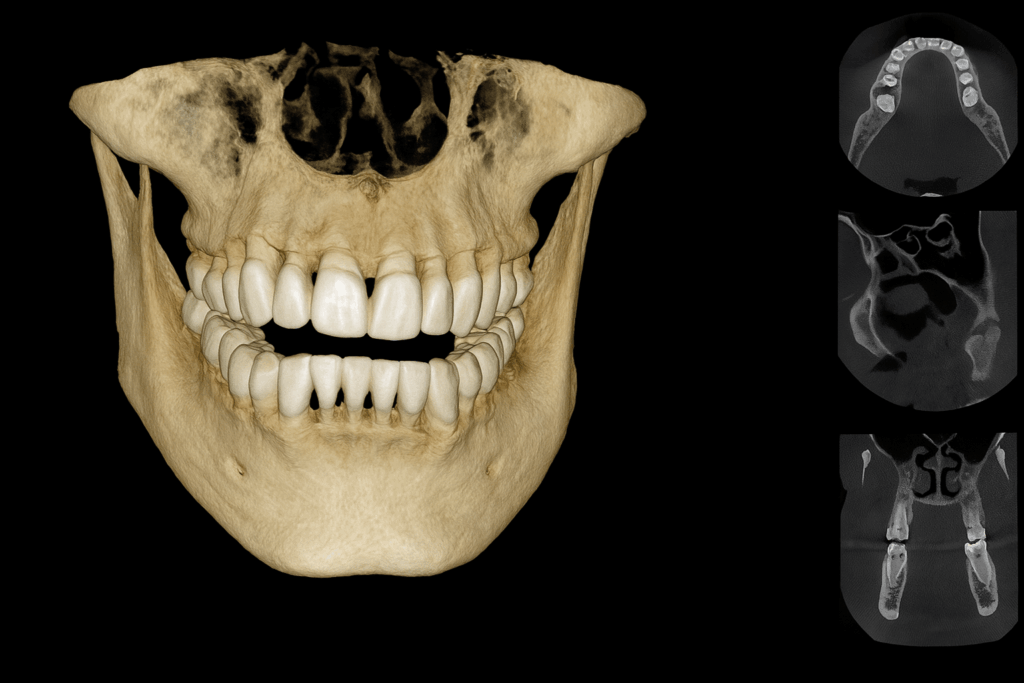Seeing clearly makes all the difference especially in dentistry. Traditional X-rays have long been a reliable tool, but today’s dental care calls for greater accuracy and detail. That’s where 3D imaging dental scans come in.
In this blog, learn how 3D imaging supports smarter, safer care plus when it might be the right choice for your next visit.
At Elizabeth L. Wakim DDS, 3D imaging is part of a comprehensive approach to modern dentistry. Every consultation includes detailed digital scans, allowing us to tailor treatment plans to your needs and goals with clarity and confidence.
What Is 3D Imaging in Dentistry?
3D imaging dental technology captures highly detailed, three-dimensional views of the teeth, jaw, and surrounding structures in just one scan. Unlike flat, two-dimensional X-rays, this method creates a full volume image that can be viewed from multiple angles, providing a deeper understanding of the mouth’s anatomy.
How It Differs from Traditional X-Rays
While traditional X-rays are still useful for routine checkups, they offer limited views and may miss important details. 3D imaging dental scans reveal far more, showing root positioning, nerve pathways, bone density, and even early signs of decay or infection. This level of detail supports more accurate diagnoses and better treatment planning.
According to a recent study published in the National Library of Medicine, 3D imaging has become a valuable tool in improving clinical outcomes particularly in identifying complex anatomical structures that are difficult to visualize with 2D radiographs.
Common Tools Used
Most dental practices use CBCT (Cone Beam Computed Tomography) scanners for 3D imaging. These machines rotate around the patient’s head, collecting hundreds of images in seconds. The result is a precise, layered model of the patient’s oral and maxillofacial structures, all while using lower radiation levels than medical CT scans.
Why Dentists Use 3D Imaging
Modern 3D imaging dental scans offer more than just high-tech visuals, they directly improve the quality, safety, and comfort of patient care. Here’s how:
- More Accurate Diagnoses: With detailed 360° views, dentists can detect hidden issues like impacted teeth, bone loss, infections, or tumors that might not appear on standard X-rays. This leads to faster, more confident diagnoses.
- Personalized Treatment Plans: Whether planning dental implants, root canals, or orthodontics, 3D imaging dental gives providers a clear blueprint of your mouth. This level of precision helps reduce guesswork and improves the chances of long-term success.
- Less Invasive Procedures: By knowing exactly where nerves, blood vessels, and bone structures are located, dentists can perform procedures with minimal disruption. That means less discomfort, fewer complications, and quicker healing.
- Faster, Safer Appointments: Scans are completed in under a minute, with lower radiation exposure than traditional CT scans. It’s a fast, safe way to gather critical information while keeping patient comfort in mind.
Dental Procedures That Use 3D Imaging
3D imaging dental scans are used across general and advanced dentistry to provide deeper insights into your oral health. According to research published in Oral Radiology, the use of CBCT and other 3D imaging methods continues to grow due to their ability to deliver accurate anatomical data while minimizing unnecessary radiation exposure. Common applications include:
Dental Implant Planning
Before placing implants, 3D scans help evaluate jawbone density, identify nerves and sinuses, and guide optimal implant positioning. This improves both safety and long-term stability.
Wisdom Tooth Evaluation
When evaluating impacted wisdom teeth, 3D imaging shows the exact position of roots, nerves, and surrounding bone. This helps your dentist avoid complications during extraction.
Orthodontic Assessments
For patients considering braces or clear aligners, 3D imaging maps jaw alignment and bite dynamics. It helps orthodontists create personalized treatment plans with greater accuracy and fewer adjustments.
Root Canal Diagnosis
3D imaging can uncover narrow canals, curved roots, or hidden infections that 2D X-rays might miss. This leads to more effective treatment and a higher success rate for endodontic procedures.
Temporomandibular Joint (TMJ) Analysis
Detailed cross-sections of the jaw joint allow for clearer evaluation of TMJ disorders, especially in cases of jaw pain, clicking, or restricted movement.
Sleep Apnea Evaluation
3D scans visualize airway obstruction and jaw structure, helping in the design of custom oral appliances for patients with mild to moderate sleep apnea.
Bone Grafting or Sinus Lifts
For patients with bone loss, 3D imaging determines whether a graft or lift is needed before implant surgery making procedures safer and more predictable.
These scans also pair well with other technologies like cosmetic laser dentistry to enhance precision and comfort in treatment planning.
What to Expect During a 3D Scan

A 3D imaging dental scan is a quick, non-invasive process that provides your dental team with a highly detailed view of your teeth, jaw, and facial structure. Here’s what typically happens:
- Before the Scan: No special preparation is needed. You may be asked to remove jewelry, glasses, or removable dental appliances. Your dentist will explain the procedure and answer any questions.
- During the Scan: You’ll stand or sit in front of the 3D imaging machine, commonly a cone beam computed tomography (CBCT) scanner. A rotating arm moves around your head, capturing multiple images in under a minute. The scan is completely painless, and there’s no contact with your skin.
- After the Scan: The digital images are instantly available for review. Your dentist uses the 3D scan to make more informed decisions, discuss findings with you, and develop a personalized treatment plan.
This advanced imaging technique allows for early diagnosis, safer procedures, and better long-term results, making it a valuable tool in both general and cosmetic dentistry. As noted by StatPearls from the National Center for Biotechnology Information, CBCT scans are increasingly used in dental and maxillofacial imaging due to their precision, speed, and diagnostic value.
For more on when and why imaging is recommended, this guide on dental X-rays explains how often they’re needed and how they support preventive care.
Get Clearer Care With 3D Imaging
When it comes to understanding your oral health, clarity matters. 3D imaging dental scans allow your provider to detect issues early, plan with precision, and deliver treatment tailored to your needs, all in less time and with greater confidence.
Our team at Elizabeth L. Wakim DDS uses advanced diagnostic tools, including 3D CBCT scanning, to help you stay one step ahead of dental concerns. From routine care to complex procedures, we believe in providing personalized, gentle dentistry backed by the latest innovations.
Ready for a more informed dental experience? Call our Pennsylvania office at (724) 558‑8222 or use our contact form to schedule your next visit.

